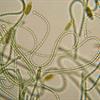Algal Blooms
Harmful algal blooms occur when several types of bacteria (known as cyanobacteria) grow in fresh, brackish, or marine waters. Under certain conditions and with sufficient nutrients, some of these bacteria can rapidly reproduce and grow into large, visible blooms that may produce harmful toxins. Harmful algal blooms are often referred to as: cyanobacteria, blue-green algae, golden algae, or simply "algae."
Potential Signs of Harmful Algal Blooms
Bright green, blue, brown, or red color to the water. It may appear as though paint is floating on the water.
Cloudy water. However, the toxins may persist for days in the water even after the cells have died and the water appears to be clear.
Very bad odor, similar to a sewer smell or rotten eggs
Dead plants and/or fish
Effects of Harmful Algal Blooms
Some harmful algal blooms produce toxins that can poison animals. Lethal poisonings have occurred when cattle or dogs have consumed toxin-contaminated water or dried algae on the shoreline. People who swim, wade, water-ski, or do other water-splashing activities are at risk of exposure to cyanobacterial toxins. No known human fatalities have been documented from recreational or drinking water exposure to cyanobacterial toxins. Health effects of exposure to harmful algal bloom toxins may include:
- Skin rashes on contact with contaminated water
- Diarrhea and vomiting if contaminated water is ingested
- Harm to the liver, kidneys, or nervous system if the toxin levels are very high



Exposure Assessment Section staff investigate the effects of harmful algal blooms to better understand how cyanobacterial toxins may get into people and cause illness. Examples of our work include:
Conducted a study of recreational exposure to cyanobacterial toxins in two lakes in Northern California with the Centers for Disease Control and Prevention. We found some evidence that dried algal mats can produce measurable toxin in the air.
Testing for cyanobacterial toxins in fish and shellfish from Clear Lake during a 2015 algal bloom event. We found no evidence of accumulation of the toxins within the edible portion of the fish, crayfish, or clams.